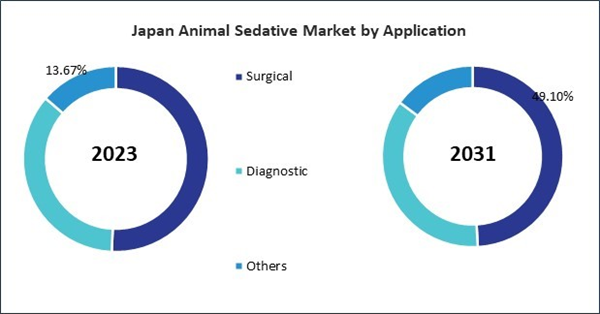The China market dominated the Asia Pacific Animal Sedative Market by Country in 2023, and is forecast to continue being a dominant market till 2031; thereby, achieving a market value of $36.14 millions by 2031. The Japan market is registering a CAGR of 5.4% during (2024 - 2031). Additionally, The India market would showcase a CAGR of 6.7% during (2024 - 2031).
Sedatives are used in laboratory settings for research purposes, including behavioral studies, surgical procedures, and diagnostic tests. They help maintain animal welfare standards and ensure compliance with ethical guidelines for animal research. Sedatives may be used in aquatic and semi-aquatic species for medical interventions and examinations. However, their use in these animals is less common and requires specialized knowledge due to the differences in physiology and handling.
Adopting animal sedatives varies across regions, and types of animals are influenced by factors such as veterinary practices, regulatory frameworks, and cultural attitudes toward animal welfare. Developed regions have well-established veterinary care systems with advanced infrastructure, including clinics, hospitals, and specialized facilities. This facilitates higher adoption rates of animal sedatives due to better access to veterinary services and advanced medical procedures.
Australia has a large and growing population of pet dogs, leading to higher demand for veterinary services. Approximately 40% of Australian households own at least one dog, according to Animal Medicine Australia, making them the most popular form of companion animal. Three in five Australian households, or 5.9 million in total, have a pet. Across Australia, 62% of households have had a dog at some point. The rising dog population has spurred the growth of veterinary clinics, hospitals, and practices throughout Australia.
Furthermore, Expanding the animal vaccine industry enhances the overall veterinary care infrastructure in India, increasing the number of veterinary clinics, hospitals, and practices. This expansion not only improves access to veterinary services but also drives the demand for pharmaceutical products, including sedatives. As per the National Investment Promotion & Facilitation Agency, the animal vaccine industry in India is valued at around $1 bn. About 10% of the world's animal healthcare industry's volume and 3% of its value are accounted for by the Indian sector. In conclusion, the increasing animal vaccine industry and the high population of pet dogs in the region are propelling the market's growth.
List of Key Companies Profiled
- Koninklijke Philips N.V.
- Hoffmann-La Roche Ltd.
- Hologic, Inc.
- Visiopharm A/S
- Paige AI, Inc.
- PathAI, Inc.
- Aiforia Technologies Plc
- Indica Labs, Inc.
- Optrascan, Inc. (Optra Ventures, LLC)
- MindPeak GmbH
Market Report Segmentation
By Route of Administration- Parenteral
- Oral
- Dogs
- Cats
- Horses
- Others
- Alpha-2 Adrenergic Receptor Agonists
- Phenothiazines
- Benzodiazepines
- Butyrophenones
- Others
- Hospitals
- Specialty Centers
- Surgical
- Diagnostic
- Others
- China
- Japan
- India
- South Korea
- Singapore
- Malaysia
- Rest of Asia Pacific
Table of Contents
Companies Mentioned
- Zoetis, Inc.
- Virbac
- Dechra Pharmaceuticals PLC
- Merck & Co., Inc.
- Bimeda, Inc.
- Ouro Fino Saude Animal Participacoes S.A.
- vetcare. fi.
- Chanelle Pharma (Exponent)
- Randlab Australia Pty Ltd.
- Troy Laboratories Pty Ltd.
Methodology

LOADING...









